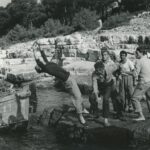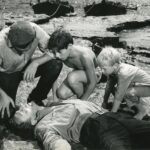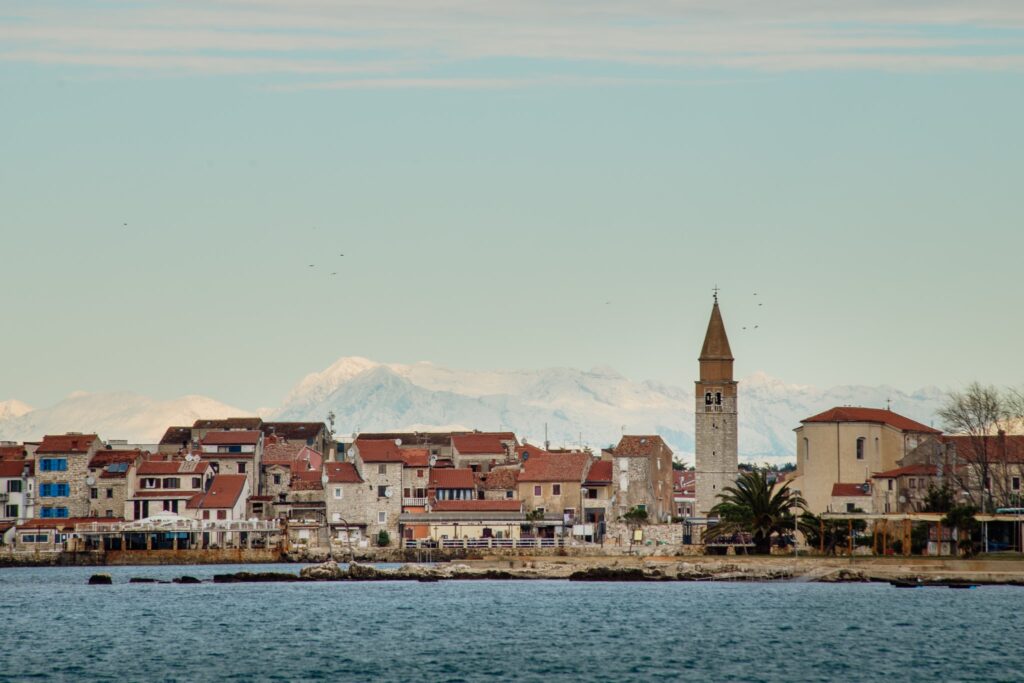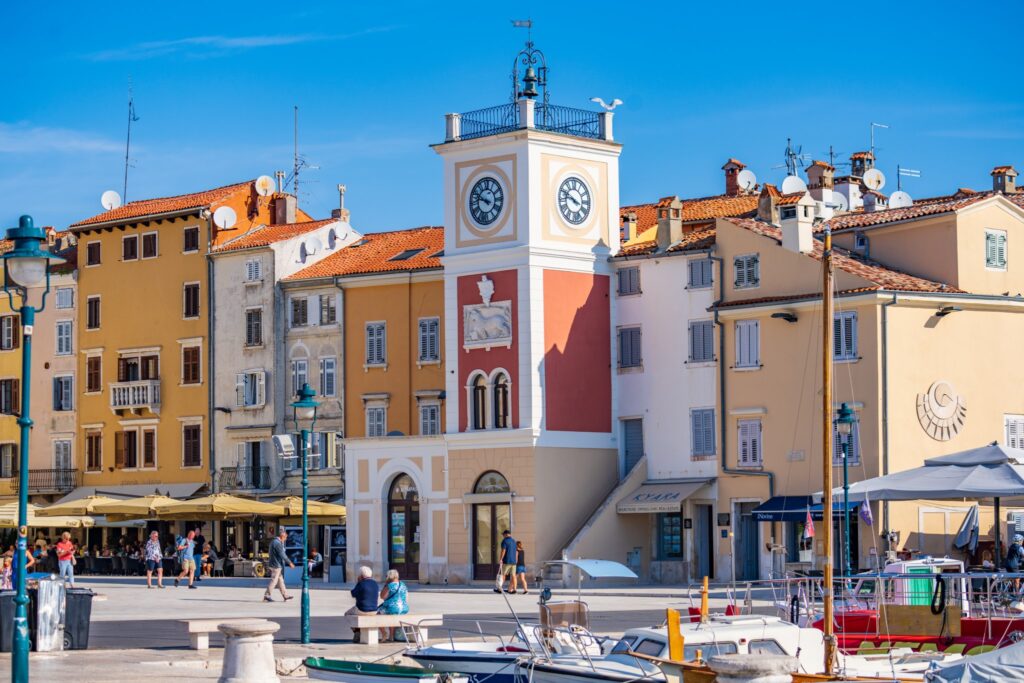
Synopsis
“La grande strada azzurra” is a romantic drama from Italian realism directed by Gillo Pontecorvo, based on the novel “Squarciò” by Franco Solinaso, who is also the co-author of the script. It follows a fisherman Squarciò who uses dynamite for illegal fishing to feed his family. Just like his fellow villagers, Squarciò fights against the poor quality of life, which ultimately costs him life. His wife is played by Alida Valli, born in Pula, and her partner is Yves Montand. Istria authentically “plays” the Mediterranean, and the film was shot in Rovinj, Umag and Vrsar, making it a precious visual document of the past times.
details
Original title: La grande strada azzurra
Also known as: Veliki plavi put; The Wide Blue Road
Year: 1957
Country of production: Italy, France, West Germany, Yugoslavia
Production: G.E.S.I. Cinematografica, Play Art, Eichberg-Film, Triglav Film
Genre: drama
Directed by: Gillo Pontecorvo
Starring: Yves Montand, Alida Valli, Francisco Rabal, Mario Girotti (Terence Hill), Federica Ranchi, Peter Carsten, Umberto Spadaro, Ronaldino Bonacchi, Giancarlo Soblone, Janez Vrhovec, Stane Potokar, Josep Batistić
Filming locations in Istria: Rovinj, Umag, Vrsar
Other locations: Bernardin, Piran, Velebitski kanal
REVIEW
LA GRANDE STRADA AZZURRA, directed by Gillo Pontecorvo, 1957
THE POETIC OF THE SEA AND FEISTY CHARACTERS
Set in a coastal fishing village, under the serenity of a light blue sky and with a view which stretches across rounded islets, “La grande strada azzurra” follows the life adventures of a fishing poacher nicknamed Squarciò, who earns his bread by (forbidden) fishing with dynamite. A charismatic French actor Yves Montand plays Squarciò, and the role of his caring wife Rosetta, the mother of their three children, is played by Pula-born actress Alida Valli. For Valli, this was second to last chance to visit the place where she was born.
Squarciò lives with his family in the house which he had built with his own hands. He enters into a conflict with other fishermen and friends from his village, who are trying to establish a cooperative. A decisive, traditional and proud man, Squarciò is both fascinating and experienced fisherman, but also a family man. But in the end, he ends up alone, torn in his own battles to prove himself and provide for his family, and is at perpetual risk of the dangerous adventures of his life.
This complex and unforgettable character played by Montand is partly a working-class hero, partly a macho cowboy, partly tanned sex symbol from the 1950s at sea, and it was made based on a true story from the La Maddalena archipelago (Sardinia), written by Franco Solinas. The screenplay was written by Solinas, Pontecorvo and Ennio de Concini.
Squarciò, sometimes referred to like that even by his minor sons, is a strong character that embodies an adventurer, a visionary and a businessman of the period of difficult circumstances. All that, together with the aesthetic determinants of the image and a large number of amateur actors, classify this film as Italian neorealism.
When the new police chief decides to thoroughly monitor Squarciò’s illegal and dangerous ventures, this threatens his source of living. The fact that he uses dynamite for fishing causes rage among other villagers, but despite that, they decide to solve that issue internally, without government interfering.
Pontecorvo’s first feature film is an emotionally strong and vibrant socialistic neorealistic melodrama, led by the author’s typical, but at the same time serious political and sociological motifs. Montand plays a stubborn and often inflexible, persistent soul whose passion for his own beliefs and love and concern for his family lead to a fatal tragedy, also the consequences of his only desire – to be one step ahead of the law. With a few dramatic flaws, such as the somewhat unclear part of the narrative arc about the daughter’s marriage, as well as Squarciò’s insufficiently realistic, almost self-imposed end to his own life on the island, due to the aforementioned characteristics from the protagonist’s life and character, the film can be classified as a neorealist, often called the neorealism of the soul.
The beautiful colour scheme that we can only admire in this film, full of emotions and passions, is a strong visual feature and an aesthetic element of Pontecorvo’s directorial début, which he directed in collaboration with Maleno Malenotti. This is largely due to the Italian photographic materials manufacturer Ferrania, a company which began its business in the late 19th century by producing nothing more than dynamite; on whose film this work was shot. Ferrani’s movie strips were preferred by Pasolini, de Sica and Fellini.
The image features exceptionally striking, beautiful sea scenes - sails in sepia tones, the shimmering emerald sea and an old fortress in the background of exquisitely open landscapes - everything looks a bit unreal, harmoniously blending together. In addition to footage of Squarciò’s dives captured by an underwater camera, in which he performs underwater stunts, that are a real minor technical marvel for the time; the culmination of sea poetics are scenes of a group of boats with a Latin sail.
The director and screenwriter Gilberto Pontecorvo was born in a Jewish family who moved to France in 1938 because of the Italian fascist race laws. During World War II, he returned to Italy and joined the Resistance. He attracted international attention with the film “Kapò” (1960) about a Jewish girl imprisoned in a concentration camp. It was nominated for an Oscar as the best foreign movie in 1961. Nevertheless, he achieved the best success with a war drama “La battaglia di Algeri” in 1966, which won numerous awards. When it comes to his direction début, he said that “...the film should perhaps have been sharper, truer, more brutal in everything, just as there should have been that breath of truth that I believe is present in all my other films, and here it is only felt in places.” I shot “La grande strada azzurra” quickly and with a very limited budget. I was constantly torn: on the one hand, the crazy and unrepeatable love you always have for your first film; and, on the other hand, the anger that I wasn’t able to do what I wanted.”
“Forse il film avrebbe dovuto essere più duro, più vero, più secco in tutto, come ci doveva essere quell’odore di verità che io credo ci sia negli altri miei film e che qui c’è soltanto a momenti. Ho girato La lunga strada azzurra in tempi stretti e con un budget molto limitato. Lavoravo sempre tra due fuochi: l’amore forsennato e irriproducibile che sempre si ha per il primo film; dall’altra parte, la rabbia di non poter fare quello che volevo.”















